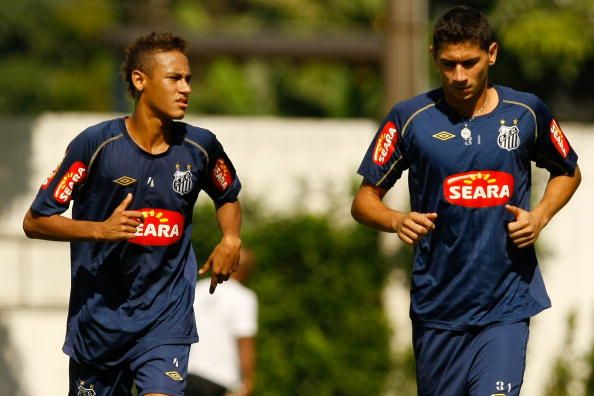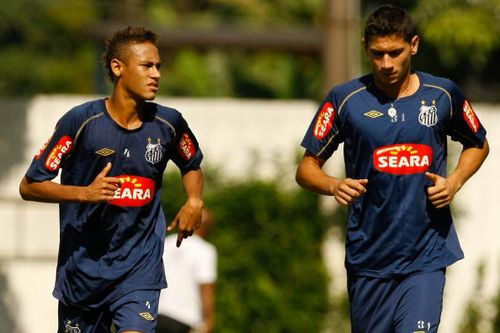
Ganso: The genius left forgotten in Neymar's shadow

Neymar (L) with Ganso at Santos FC
Everybody wants Neymar. He is the next big sensation to burst onto the global football scene. For months now, newspapers in football-crazy Europe have speculated over which club will fork out the massive £40 million being quoted as his asking price. The Sun will link him to Manchester City, whose Arab sheikh owners have cash reserves so vast they make Neymar’s asking price look like small change. The Mirror will fire up in response, extrapolating a path between Chelsea and Santos, with a few paragraphs that detail the immense wealth Roman Abramovich possesses.
But few nations will let the English press hog all the glory. From Spain will come articles in Marca and AS, each attempting to garner support towards Real Madrid and Barcelona. One will speak of rumblings behind the scenes of gentlemanly agreements between the Spanish clubs and their Brazilian counterpart, while another will claim a deal is in place to lure the Brazilian to Europe after his contract expires in 2014.
Neymar caught the world’s attention because of his exploits with Santos, whom he helped win the Regional Championship in 2010 and the Brazilian Cup that year.
But while Neymar was banging in the goals and hogging the international limelight, one of the reasons his team has racked up cricket scores against the opposition is because of the service he gets. Service that is not present to aid him at Santos any more.
Paulo Henrique Ganso was the chief supplier of passes which Neymar converted into goals and consequently wins.
When Neymar burst onto the scene aged just eighteen, he was always mentioned as one half of a duo; Ganso, two years his senior, being the other half of that deadly double which has played a massive part in earning Santos the worldwide recognition associated with the two Brazil internationals.
The duo had been signed by the Peixe at the same time. Neymar was a gangly 13-year-old and Ganso 15. The two grew up together, rarely spending time apart off the pitch and developing a telepathic bond on it. Common parents aside, they were brothers. And that connected translated to success in the form of trophies for one of Brazil’s oldest clubs.
But we live in a world that is best reflected by Real Madrid’s transfer policy during the era of the original Galacticos. Vicente del Bosque wanted a defender to bolster the Madrid rearguard. He was instead given Michael Owen.
Strikers are valued more than other players because there is so much more that meets they eye when they are observed. Given that what they do directly affects the success of their team at face value, their market rates are often significantly higher than either defenders or midfielders, whose qualities are more often than not less tangible.
Given the hoopla that the mohawk-styled striker was generating, Santos decided to insure their prized talent by offering him a bumper contract that would see him stay at the club till at least 2014, giving him more time to mature as a player and providing him the perfect opportunity to put himself in the shop window by showing he could play with the best of the best when he takes to the field in the 2014 FIFA World Cup which will be held in Brazil.
But Santos have never been a club with stable financial backing. In the 1960s, the club cashed in on Pele’s super stardom by foregoing titles and touring the world to play friendlies and increase their presence in the international football market. It is a similar situation with Neymar. To keep him at the club, they offered him astronomical wages which required them to close their futsal division and their ladies football team.
While all this was happening, Ganso was in the club’s plans, but was largely overlooked in favour of the number 11. He was ultimately offered a new contract, but turned it down, since he had one bone of contention with the top brass.
He was not given the same wages as Neymar.

Having turned it down, he offered his team an ultimatum: give him the same wages as Neymar or he was going to a club that would recognise him for his talent. With both sides reaching an impasse, the playmaker called on his legal team to sort out the situation with the club’s administrators. The fault lay not with Neymar, but the manner in which the club had handled the man he called his brother. He may be only 21, but Neymar knew exactly what was happening behind the scenes:
“I have had to repeat for three years that I will stay at Santos. Everyone knows that I will stay at Santos until 2014. I may or may not sign a new deal (after that); I will only know that when the time comes.
“But (Ganso) has not told me yet if he is going to leave. If I had to talk not about the friend, but the player, I would say that everyone wants to have someone like him on the team. I do not know much about what is happening. I ask him not to abandon me. I hope he will not go far away from me.”
- Neymar in 2012
In the end, frustrated at not being given the same respect as his more publicised compatriot, Ganso’s instructed his agent to find him a new club. When the great Brazilian playmakers of the modern era are named, Ronaldinho and Kaka are two of the first names that first come to mind. But while they do have great qualities which make them excellent team players, they are more remembered for their individual qualities which do turn games but prompt people to remember them, not the teams they play for. When one remembers Kaka in the AC Milan shirt, what comes to mind is the midfielder pointing his fingers in salutations to the heavens after scoring a goal. Barcelona have always been a great team, but it is Ronaldinho’s cheeky grin captured by the cameras that people remember.
Ganso was a complete team player and so much more. As the BBC’s Tim Vickery says:
“No doubt about it, the talent is there. This is a player who is strong in possession, with the vision to see the killer pass and the technique to play it.
“There is the view that contemporary Brazilian football offers rich pickings for playmakers. Yet the country has struggled recently to produce attacking midfielders whose game is collective, who dictate the rhythm and bring team-mates into play with inspired passing.”
Santos have lost one of their great players. While they had a massive hand in making him the player he is today, they mismanaged his financial requirements. They too were ensnared by the spotlight cast on Neymar. He therefore moved to Sao Paulo, for a reported fee of $23.9 million. Having joined their arch rivals, he is allegedly being given a fee of $230,000 a game. In a world where player wages are constantly inflated, one might argue that both Brazilians are being paid far too much given their young age, but it is only fair for Ganso to get the same fee as Neymar, especially since he has contributed as much as Neymar if not more.
His agent could not have put it better:
“Ganso will not play for Santos again. That is guaranteed. He could play for Internacional. I am negotiating his purchase from Santos. Ganso is upset with the club. They put together a project for Neymar but forgot about him. He wants to leave but he also wants to stay in Brazil for at least another year.”
- Ganso’s agent Delcir Sonda
Papers in Europe claim that AC Milan and Porto are interested in Ganso. Given the circumstances, his move to Sao Paulo is for the greater good. Neymar will learn to play with other team mates while continuing to be the star at Santos, while Ganso can concentrate on football, having sorted out this ugly situation. Everybody wins.
Except Santos, who let go of one of their best players when they could have kept both happy.